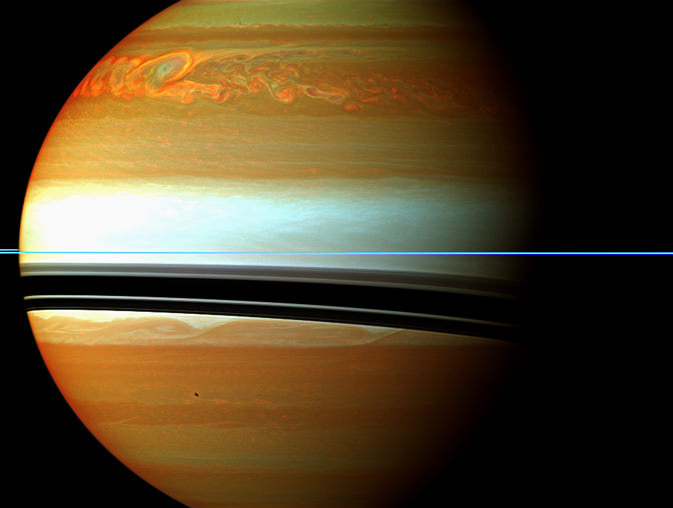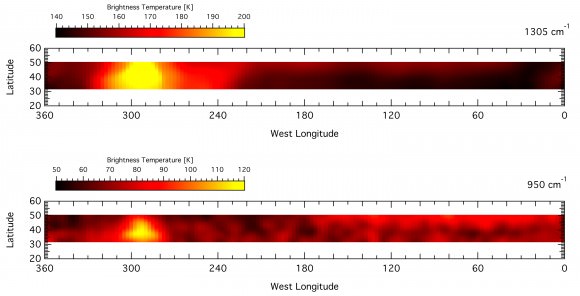In 2010, a small, bright white storm emerged on Saturn’s northern hemisphere. This storm grew until it wrapped around the planet in curly cloud structures, creating a colossal atmospheric disturbance that endured into the early part of 2012, becoming the largest storm seen on the planet since 1990. Being in orbit around the ringed planet, the Cassini spacecraft had a front row seat to watch the disturbance unfold, allowing planetary scientists an unprecedented look at this monster storm. While the storm was visible even to amateur astronomers on Earth, much of its activity took place beyond the reach of visible-light cameras and telescopes, astronomers say. Not only did huge “beacons” of hot air chase each other around the planet, but infrared observations show a giant oval vortex is still persisting as a side effect from the storm.
“It’s the first time we’ve seen anything like it on any planet in the Solar System,” said Leigh Fletcher from the University of Oxford, UK, lead author of a paper describing the unprecedented storm. “It’s extremely unusual, as we can only see the vortex at infrared wavelengths – we can’t tell that it is there simply by looking at the cloud cover.”
Fletcher and her team also used ground-based observations with the Very Large Telescope of the European Southern Observatory in Chile, and NASA’s Infrared Telescope Facility at the summit of Mauna Kea in Hawaii.
As the visible storm erupted in the roiling cloud deck of Saturn’s troposphere, waves of energy rippled hundreds of kilometers upwards, depositing their energy as the two vast ‘beacons’ of hot air in the stratosphere.
Data from Cassini’s composite infrared spectrometer (CIRS) instrument revealed the storm’s powerful discharge sent the temperature in Saturn’s stratosphere soaring 65 degrees C (150 degrees Fahrenheit, 83 kelvins) above normal.
Researchers described in a complimentary paper that will be published in the Nov. 20 issue of the Astrophysical Journal this as a “belch” of energy, as they observed a huge increase in the amount of ethylene gas in Saturn’s atmosphere, the origin of which is a mystery. Ethylene, an odorless, colorless gas, isn’t typically observed on Saturn. On Earth, it is created by natural and man-made sources.
Researchers are still is exploring the origin of the ethylene, but they have ruled out a large reservoir deep in the atmosphere.
“We’ve really never been able to see ethylene on Saturn before, so this was a complete surprise,” said Goddard’s Michael Flasar, the CIRS team lead.
The beacons were expected to cool down and dissipate, but by late April 2011 – by which time bright cloud material had encircled the entire planet – the hot spots had merged to create an enormous vortex that for a brief period exceeded even the size of Jupiter’s famous Great Red Spot.
The forceful storm generated unprecedented spikes in temperature and increased amounts of ethylene. In these two sets of measurements taken by Cassini’s composite infrared spectrometer, yellow represents the highest temperatures. Each strip maps a single molecule (top: methane, bottom: ethylene), with temperature measurements taken in the northern hemisphere, all the way around the planet. Image credit: NASA/JPL-Caltech/GSFC
Although comparisons to Jupiter’s Red Spot have been made to this storm, Saturn’s storm was much higher in the atmosphere while Jupiter’s vortex is embedded deep down in the turbulent ‘weather zone’, Fletcher said.
Also, Jupiter’s famous vortex has raged for at least 300 years. But after traversing the planet once every 120 days since May 2011, Saturn’s large beacon is cooling and shrinking. Scientists expect it to fade away completely by the end of 2013.
The question now remains as to whether Saturn’s storm-generating energy has been sapped or if there will be a repeat performance, the team said.
The outburst already caught observers by surprise by arriving during the planet’s northern hemisphere spring, years ahead of the predictably stormy summer season.
“The beauty is that Cassini will be operating until the Saturn system reaches its summer solstice in 2017, so if there is another global event like this, we’ll be there to see it,” says ESA’s Cassini project scientist Nicolas Altobelli.



New and old Science
A new and Progressive Science shows how
Wavevolution, or the transformation from waves to atoms, is the
connecting link that closes the circle of science to open our eyes
toward new horizons never seen before.
The bureaucracy of traditional science prevents the recognition of
any
event unless certain criteria are first met. The problem of this
science is buried deep in the compilation of these “laws” or criteria
introduced by a few scientists in the name of all science and from their
erroneous understanding of the relation between Space and Time. This
antiquated system of rules also results in misleading theories.
For example, Space is not “curved”.
In Einstein’s paradigm, a stone that falls on the ground from the
window
of a moving train also marks one parabola in Space. Although, this path
is only apparent since the Earth is also moving and the Time spent by
the stone to reach the ground has also changed to some degree that
imaginary vertical line. At the Time of the initial Movement when the
stone falls from the window
its potential trajectory is one
perpendicular Space that is no longer the same as the stone continues to
move until it hits the ground. If the scientist had known that the
coordinates of Space in Time are unique and unrepeatable then all the
rest would have also been “straight”. That perpendicular is straight but
accounted as “curve” because of the limits of science unable to
recognize the issue of simultaneity. In reference to each body on each
moment in Time there are always only two coordinates in Space for one
perpendicular.
And with two coordinates there is no curve.
One
perpendicular is unrepeatable and never the same because while the
measure of it is repeatable and any measurement can be applied for
different segments instead one perpendicular marked in Time is like an
imprint on clay with one mold that is not repeatable. These are the
limits of science in regard to simultaneity and repeatability that like a
white flag surrender traditional science to Religion.
The perpendicular changes in Time but Einstein believed that the concept of Space is independent from the concept of Time.
Another
example is in the special theory of relativity which denies all
absolutes and meanings of truth. This is in regard to Einstein’s example
of two beams of light hitting one same embankment of a railroad on two
Points: Point A and Point B. In between the two there is also the middle
point, Point M. If one train were to run over that track then on the
train we would also have Point A1 on the wagon of the train
correspondent to above Point A and also one other corresponding Point B1
right above Point B. We would also have on the train the corresponding
Point M1 above Point M. Einstein’s theory is that as for Point M (not
moving because on the embankment) those two beams are simultaneous and
equidistant, instead, for the passenger sitting on M1 and moving towards
Point B1 (and also toward Point B) the two beams are not simultaneous
because the beam in Point B1 is being approached by the moving train,
therefore closer to M1. In this example, while Einstein’s concept of
Time is rigidly kept unchanged in regard to the embankment, instead, the
concept of Space is extended also to the next moment in Time when the
traveler will move even if in that precise instant the traveler has not
moved yet. Since the concept of simultaneity had been put aside,
Einstein considered Time to be the same while Space instead had changed.
Also, this same scientist erroneously believed that all colors in the light spectrum travel at the same speed.
Much confusion comes from these approximations.
One new Awareness will be found in between the winding creativity of the human mind and the rigid logic of numbers.
http://www.wikinfo.org/Multilingual/index.php/Wavevolution
http://www.wavevolution.org/en/humanwaves.html
aliens nuke themselves too… (a solid core in Saturn is speculated to exist after all)
Perhaps the Saturnians are awaking from their slumber ?
Heh , it’s 2012 after all .
As Alice said in a dream-like Wonderland, “Curiouser and curiouser.” The closer we look, – whether down into the surreal properties and behaviors of inner atomic space, or up into the unseen forces and masses of outer celestial space, – “curiouser and curiouser” become the objects of our four-dimensional reality, whatever their nature, scale, distance, or location, in subject details of studied time. Whether they be Quasars at the edge of the beginning, or giant Storm-World’s climatic changes, seen in our Home-Star’s light, under cold shadow of icy Rings glowing bright.